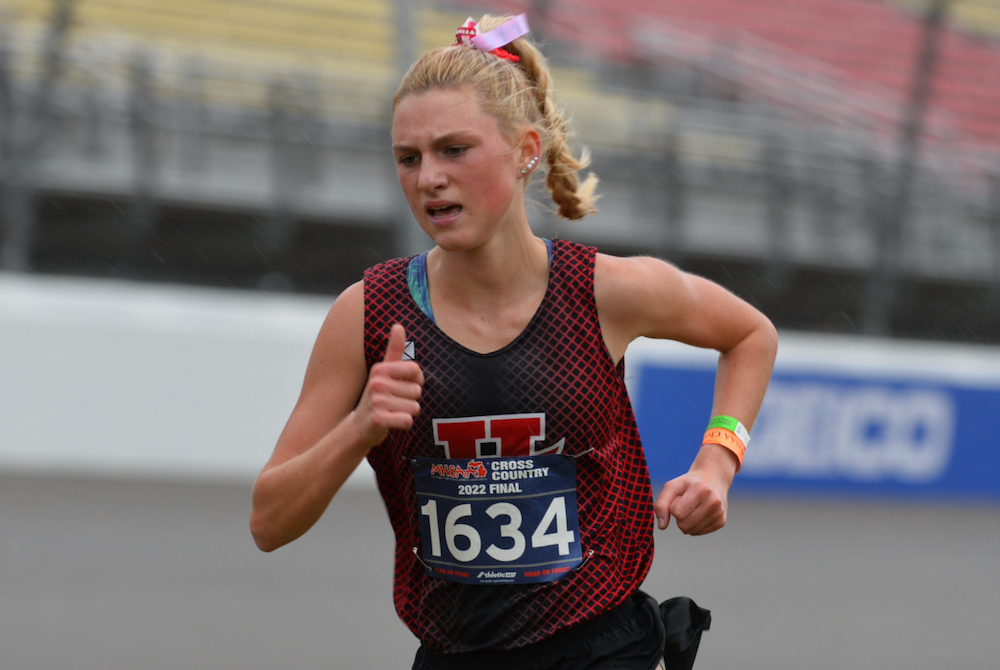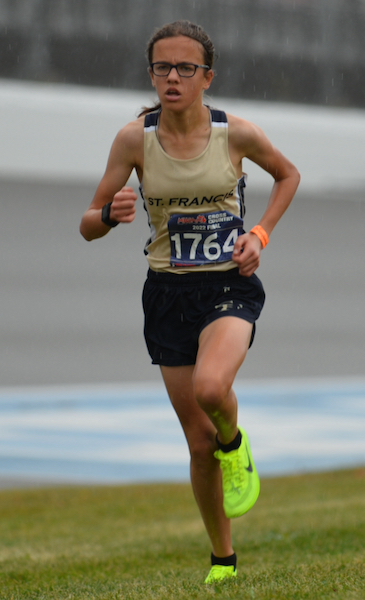
Beal City Repeats, St. Phil Soph Surges
November 1, 2014
By Bill Khan
Special for Second Half
BROOKLYN — Ava Strenge's goals were constantly being upgraded as she made her way along the five-kilometer cross country course at Michigan International Speedway on Saturday.
She didn't come into the MHSAA Lower Peninsula Division 4 meet as one of the favorites, having placed 73rd last year on what was admittedly a bad day.
"I was hoping for a top 10, at best," the Battle Creek St. Philip sophomore said.
Then the race started to unfold. Strenge found herself near the front of the pack, within striking distance of first place.
"Maybe at the mile point, I was second or third, and I thought I could do a top three," she said.
And winning?
"I didn't think about that until that straightaway," she said.
Turning on the jets down the final long straightaway at MIS, Strenge won a three-girl battle for the championship with a time of 18:54.5.
Sophomore Alexis McConnell of Mount Pleasant Sacred Heart was second in 18:58.1, while freshman Mary Ankenbauer of Kalamazoo Hackett took third in 18:58.6.
"I was really relieved," Strenge said. "Usually the straightaways are where people get me, because I'm not a good sprinter. I can't go that fast."
Strenge beat her personal best of 19:14.6 set in the regional meet.
It was a much better finish to the season for Strenge, who ran 21:13.3 at MIS last year after dipping below 20 minutes four times during the season.
"The nerves," she said, trying to offer up a reason for last year's disappointment. "I might have overtrained that last week, because it was my first year and I was really excited. I might have overdid it."
 Beal City, which returned six of seven runners from last year's championship team, repeated as the team title winner with 94 points.
Beal City, which returned six of seven runners from last year's championship team, repeated as the team title winner with 94 points.
Hackett was second with 108, followed by Sacred Heart with 130.
Senior Emily Steffke and junior Hannah Steffke led Beal City, taking fifth (19:15.0) and sixth (19:26.0), respectively. Senior Hayley Neyer also made the top-30 all-state range, placing 27th in 20:17.6. Freshman Madeline Steffke, the only newcomer to the lineup, was 41st in 20:40.6. Sophomore Ariel Salter completed the scoring, taking 55th in 20:55.4.
Hackett had four runners cross before Beal City’s fourth did, but there was a 16-point difference between the schools' fifth and final scorer.
PHOTOS: (Top) Battle Creek St. Philip’s Ava Strenge capped her sophomore season by improving 72 places to win the LP Division 4 title. (Middle) Beal City’s Emily Steffke (745) and North Muskegon’s Avery Lowe race for top-five finishes; Lowe ended up fourth and Steffke fifth for the team champion Aggies. (Click to see more from RunMichigan.com.)

Jazwinski Brings Hart Individual Title as St. Francis Moves to Front of Team Pack
November 5, 2022
BROOKLYN – Cross country races can be won between the ears before runners ever step foot onto the course.
Attitudes were tested as rain began to descend on Michigan International Speedway and the wind picked up just before the start of the MHSAA Lower Peninsula Division 3 girls race late Saturday morning.
Hart sophomore Jessica Jazwinski was loving life as she prepared to race.
“As a distance runner, I really try to love the wind,” she said. “Distance running and cross country is just a tough sport. The wind just adds to it — and the rain, too. It’s super fun.
“I was just thinking these conditions are just gonna feed my great race. This is real cross country. Yeah!”
Jazwinski overcame the elements to run the fifth-fastest Division 3 time ever, winning with a time of 17:36.70. She has two of the top-five times in Division 3 Finals history, having run 17:31.4 to place third last year.
“Today my race plan was just to go out hard and try to hold on to my pace,” she said. “I feel like I tried to race a lot like Steve Prefontaine, just go out and hold on.”
 Lansing Catholic senior Hannah Pricco was second in 18:17.59, Onsted sophomore Emmry Ross was third in 18:20.96 and Hart junior Alyson Ens was fourth in 18:28.52.
Lansing Catholic senior Hannah Pricco was second in 18:17.59, Onsted sophomore Emmry Ross was third in 18:20.96 and Hart junior Alyson Ens was fourth in 18:28.52.
“I love having great teammates to work with and encourage each other,” Jazwinski said. “We really try to encourage each other so much throughout the races. Throughout this year, some races she’s been a minute behind me, some races she’s been five seconds. I don’t want her to ever beat me, so that pushes me so much. I know she’s trying to race me and get up there with me.”
The only downer for Hart was having its string of Division 3 championships end at five with a fourth-place finish. Hart had two runners in the top four, but its No. 3 runner was 68th.
“I would totally trade my individual title for a team title,” Jazwinski said.
Traverse City St. Francis emerged from a close battle to win its first title since 2016 with 134 points. Pewamo-Westphalia was second with 142 and Lansing Catholic third with 165.
Sophomore Betsy Skendzel led St. Francis, placing seventh in 18:48.33. Completing the team score were senior Sophia Rhein in 26th (19:43.27), sophomore Grace Slocum in 33rd (20:07.95), junior Rylee Duffing in 60th (20:44.82) and junior Margot Hagerty in 63rd (20:45.78).
Lansing Catholic had three place in the top 10, but didn’t get another finisher until 103rd.
PHOTOS (Top) Hart’s Jessica Jazwinski pushes toward the finish during Saturday’s LPD3 Final. (Middle) Traverse City St. Francis’ Betsy Skendzel leads the way for the eventual team champion. (Click for more from Dave McCauley/RunMichigan.com.)

